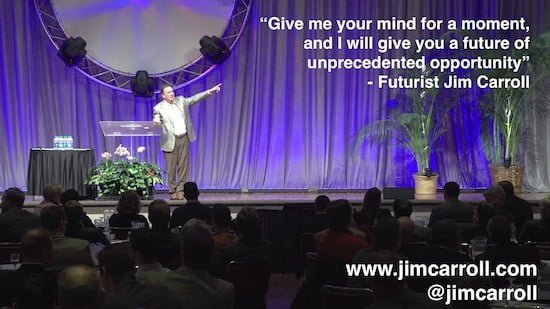In my keynotes, I often talk about how the rate of change — whether with business models, product life cycles, the rapid emergence of new competitors, business model disruption, skills and knowledge and more! — is speeding up. With such change, there’s a lot of uncertainty within many industries as to what to do next: a senior executive of one client commented to me from his perspective, “….entities are engaged in survival tactics because they don’t know what to do next ….”
Here’s a simple reality: Innovation is all about adapting to the future — and if the future is coming at you faster, then you need to innovate faster.
Given that, innovation shouldn’t be about trying to survive the future — it should be about thriving.
At a recent keynote to senior executives, I outlined some truths as to the future:
- It’s incredibly fast: Product life cycles are collapsing. It’s said that half of what students learn in their freshman year about science and technology is obsolete or revised by their senior year. There are furious rates of new scientific discovery. Time is being compressed.
- It involves a huge adaptability gap: Earlier generations — boomers — have had participated in countless “change management workshops,” reflecting the reality that many of them have long struggled with change. Gen-Connect — today’s 35 and under — will never think of change management issue. They just change.
- It has a huge instantaneity: The average consumer scans 12 feet of shelf space per second. Most news becomes old hat within 36 hours of emerging. Rapid prototyping, 3D printing and the maker community mean that a product can go from conception to reality in a matter of weeks – if not days. We live in the era of the rapid idea-cycle.
- It hits you most when you don’t expect it: Every organization must deal with two realities: the rapid emergence of new technologies, and the sudden adoption of old-hat ideas. If you want to understand what comes next, study Gartner’s concept of “hype-cycles”
- It’s being defined by renegades and rebels: Increasingly, the future of many an industry is being defined by industry expatriates. When a real innovator can’t innovate within a company, they step outside, form a startup, and spark massive industry change on their own. Before you know, they’ve reinvented you, whether you like it or not
- It involves partnership: Old business models involved asking, “what can we do to run our business better?” The new business model is this: “What can we do to run our customers, suppliers and partners business better?“
- It involves intensity: 80% of the revenue from the typical video game is earned within 4 to 5 days of release. That’s becoming the norm in many industries — although not in days, but perhaps months. Companies are discovering their new reality involves short, sharp shocks of revenue, followed by a need to constantly re-asses and reinvent. We must learn to run our business at video-game intensity: in fast paced markets, we need fast paced business capabilities!
- It’s bigger than you think: I used to joke, back in 2003, about a futuristic GoogleCar, and an era in which Silicon Valley would become the new centre of the automotive universe. With self-driving cars and other efforts, its not a joke anymore. Every industry is witnessing similar levels of disruption and acceleration. Complacency is a dangerous thing, particular when every organization is faced with constant, relentless external innovation from unexpected competitors.
- It involves innovation intensity: With rapid change, everyone in an organization must innovate. Some years ago, I appeared on a the CNBC Business of Innovation show. It featured a lot of “innovation elitists” who seemed to indicate that only special people can “do” innovation. Wrong : thriving in the future has a leadership that involves everyone in innovation. No idea is too dumb, no opportunity is too small. In an era of fast change, organizations must be relentlessly innovative, and that requires drawing on the skills and creativity of everyone
- It comes from experiential capital: With a fast future, you must learn and relearn. Corporate equity isn’t just money: it’s the cumulative experience and knowledge of the team. Yeas ago, Verizon took a lot of abuse from analysts for its’ big fiber optic bet, yet here’s what I see: the CEO stating that the cost of installing fiber dropped 30% in 2005, and that there was a further reduction of 15-20% by 2006. By the end of end of 2006, they expected it to cost 1/2 that of 2005. The more they do, the better they get. That’s experiential capital, and that’s an invaluable asset.
The future is going to hit you whether you like it or not; it’s your approach to it, and how you innovate with it, that defines your future success.





GET IN TOUCH
Jim's Facebook page
You'll find Jim's latest videos on Youtube
Mastodon. What's on Jim's mind? Check his feed!
LinkedIn - reach out to Jim for a professional connection!
Flickr! Get inspired! A massive archive of all of Jim's daily inspirational quotes!
Instagram - the home for Jim's motivational mind!